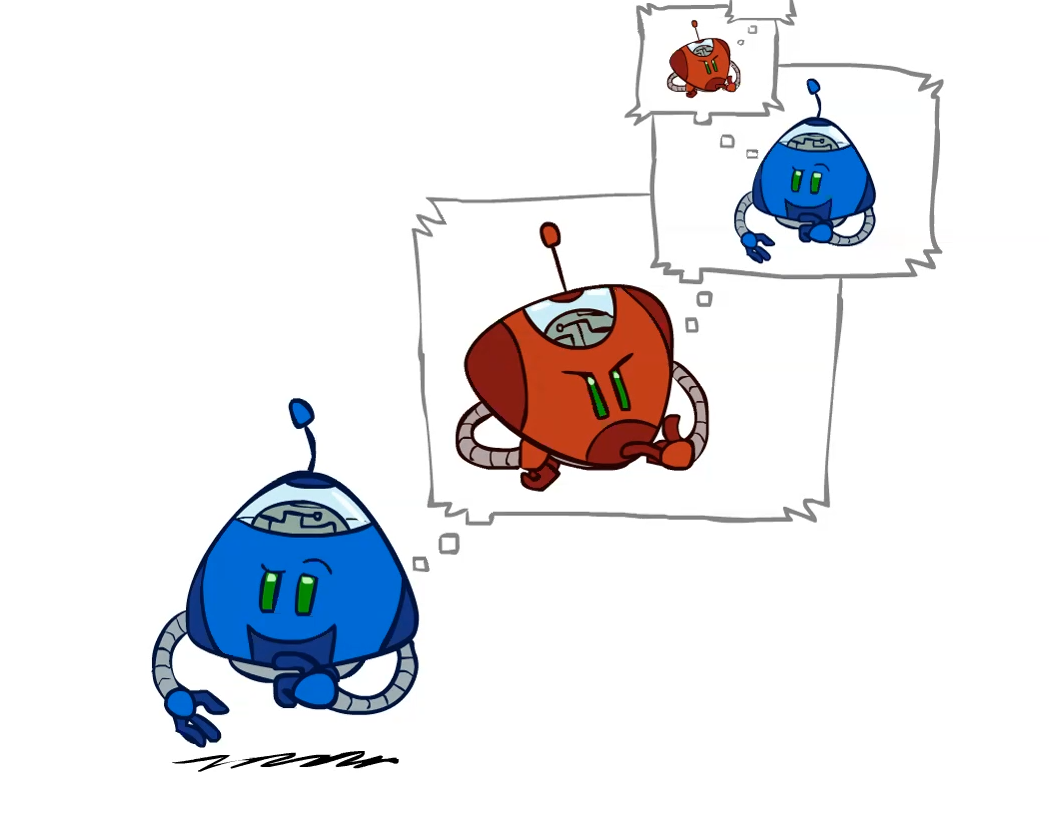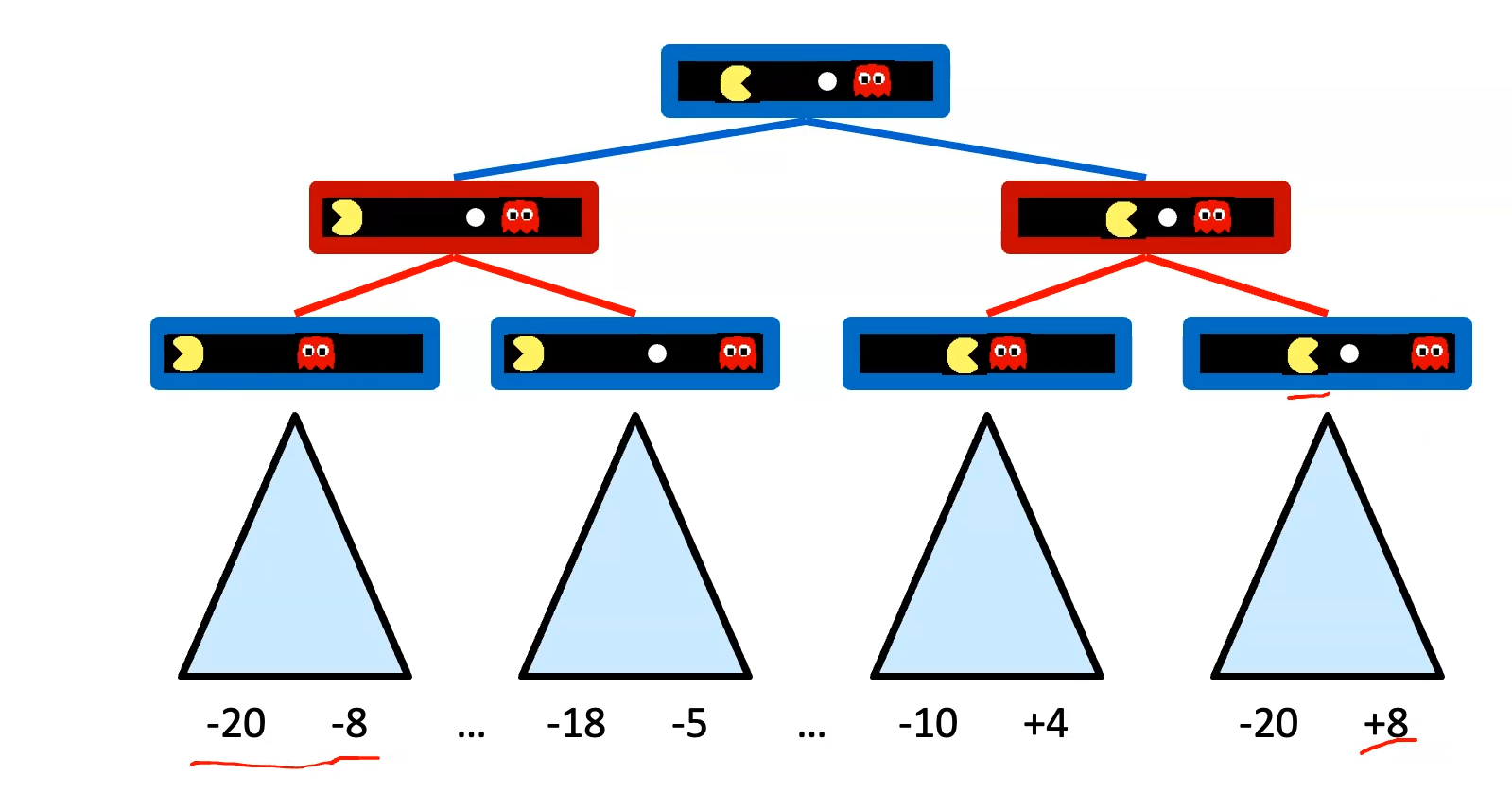Adversarial Games
- Adversarial games are everywhere, i.e. Tic Tac Toe, Checkers, Chess etc
- Many different kinds of games
- Axes:
- Deterministic vs Stochastic
- One, two or more players
- Zero sum vs General sum
- Perfect information (can you see the state) vs Partial information
- Algorithms need to calculate a strategy (policy) which recommends a move (action) from each position (state)
- This differs from previous Search Problems
Deterministic Games
Problem Formulation
- States: (start at )
- Players: (take turns)
- ToMove(s): the player whose turn it is to move in state
- Actions(s): the set of legal moves in state
- Result(s, a): the Transition function, state resulting from taking action in state
- IsTerminal(s): a terminal test, true when the game is over
- Utility(s, p): -> a number: final numeric value to player when the game ends in state Solution for a player is a policy which maps a state S to an action A
Zero-Sum Games
- Agents have opposite utilities (values on outcomes)
- If player 1 does something positive, its negative for player 2
- Can then think of outcome as a single value that one maximizes, and the other minimizes
- Adversarial, pure competition
General Games
- Agents have independent utilities
- Cooperation, indifference, competition, and more are all possible
Optimal Decisions in Games
Adversarial Search

- Single Agent Trees
- For each state we figure out the best achievable outcome (utility) from that state
- For terminal states that value is known
- Non-terminal states:
- For each state we figure out the best achievable outcome (utility) from that state
- Adversarial Game Trees
- We use a similar concept, but now we can include the opponents moves after our move to see the best states and choose the best path

- Minimax Search
- Use in Deterministic, Zero-sum games:
- Tic tac toe, chess, checkers
- One player maximizes result
- The other minimizes result
- A state-space search tree
- Players alternate turns
- Compute teach nodes minimax value: the best achievable utility against a rational (optimal) adversary
- Use in Deterministic, Zero-sum games:
- Implementation
def max-value(state):
initialize v = -infinity
for each successor of state:
v = max(v, min-value(successor))
return v
def min-value(state):
initialize v = +infinity
for each successor of state:
v = min(v, max-value(successor))
return v
The two functions just keep calling each other recursively
def value(state):
if the state is a terminal state return the states utility
if the states agent is MAX return max-value(state)
if the states agent is MIN return min-value(state)
Minimax is optimal against a RATIONAL player. If they aren’t being rational and choosing randomly then it might not be optimal to keep using the min max.
- Minimax Efficiency
- Just like exhaustive DFS
- Time
- Space
- So the real question is, is it necessary to explore the entire tree? Can we cut things to reduce the amount of time we are searching?
Alpha Beta Pruning
- We can sometimes prune paths from the tree to go faster
- General configuration (MIN version)
- When computing the MIN-VALUE at some node
- We loop over ’s children
- ’s estimate of the children’s min is dropping
- Who cares about ’s values? MAX
- Let be the best value that MAX can get at any choice point along the current path from the root so far
- If becomes worse than , MAX will avoid it, so we can stop considering ’s other children
- MAX version is symmetric, just flip MIN to MAX, change alpha to beta, and, worse to better etc
- Combine the two you get alpha beta pruning
- Implementation
alpha: Max's best option on path to root
beta: Min's best option on path to root
def max-value(state, alpha, beta):
initialize v = -infinity
for each successor of state:
v = max(v, value(successor, alpha, beta))
if v >= beta return v
alpha = max(alpha, v)
return v
def min-value(state, alpha, beta):
initialize v = +infinity
for each successor of state:
v = min(v, value(successor, alpha, beta))
if v <= alpha return v
alpha = min(beta, v)
return v
Properties
-
This pruning has no effect on the minimax value computed for the root
-
However, the values of the intermediate nodes might be wrong
- Important: children of the root may have the wrong value
- So, the most naïve version won’t let you do action selection
- Need to keep track which nodes have been pruned
-
Good child ordering improves effectiveness of pruning
-
With “perfect ordering”
- Time complexity drops to
- Doubles solvable depth
-
In most realistic games you cannot search to the leaves
-
So instead we can check to a certain depth
-
Depth-limited search
- Instead, search only to a limited depth in the tree
- Replace terminal utilities with an evaluation function for non-terminal positions
- Guarantee of optimal play is gone; more depth makes a big difference
Heuristic Alpha Beta Pruning
- Use Evaluation functions!
- Treat nonterminal nodes as if they were terminal
- Eval(s): Evaluation function
- IsCutOff(s) a cutoff test, true when we stop searching
- What should we use for the evaluation functions?
- Desirable properties
- Order terminal states in same way as true utility function
- Strongly correlated with the actual minimax value of the states
- Efficient to calculate
- Typically us features - simple characteristics of the game state that are correlated with the probability of winning
- The evaluation function combines feature values to produce a score
- Desirable properties
- Evaluation functions are always imperfect
- The deeper in the tree the evaluation function is buried, the less the quality of the evaluation function matters
- An important example of the tradeoff between complexity of features and complexity of computation
Monte Carlo Tree Search (MCTS)
- Instead of using a heuristic evaluation function, can we esitimate the value by averaging utility over several simulations
- Smimulation (also called playout or rollout) chooses moves first for oen player, then the other, repeeating until a termianl position is reached
- Choose moves either randomly or according to some playout policy (choose good moves)
- Exploration (try nodes with few playouts) vs exploitation (try nodes that have done well in the past)
Stochastic Games
What if a game has a “chance element”?
- Our game tree gets much larger
- The sum of the probability of each possible outcome multiplied by its value:
- Now three different cases to evaluate, rather than just two
- MAX, MIN, CHANCE
- EXPECTED-MINIMAX-VALUE(n) =
- Utility(n) if terminal node
- max expected-minimaxvalue if its a max node
- min expected minimax value if min node
- P(S) times expected minimax value for every successor summed if a chance node